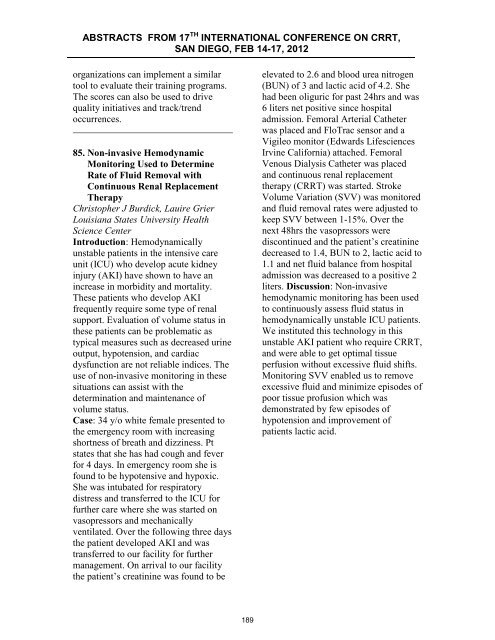ABSTRACTS from 16th International COnference on ... - CRRT Online
ABSTRACTS from 16th International COnference on ... - CRRT Online
ABSTRACTS from 16th International COnference on ... - CRRT Online
Create successful ePaper yourself
Turn your PDF publications into a flip-book with our unique Google optimized e-Paper software.
<str<strong>on</strong>g>ABSTRACTS</str<strong>on</strong>g> FROM 17 TH INTERNATIONAL CONFERENCE ON <strong>CRRT</strong>,<br />
SAN DIEGO, FEB 14-17, 2012<br />
organizati<strong>on</strong>s can implement a similar<br />
tool to evaluate their training programs.<br />
The scores can also be used to drive<br />
quality initiatives and track/trend<br />
occurrences.<br />
85. N<strong>on</strong>-invasive Hemodynamic<br />
M<strong>on</strong>itoring Used to Determine<br />
Rate of Fluid Removal with<br />
C<strong>on</strong>tinuous Renal Replacement<br />
Therapy<br />
Christopher J Burdick, Lauire Grier<br />
Louisiana States University Health<br />
Science Center<br />
Introducti<strong>on</strong>: Hemodynamically<br />
unstable patients in the intensive care<br />
unit (ICU) who develop acute kidney<br />
injury (AKI) have shown to have an<br />
increase in morbidity and mortality.<br />
These patients who develop AKI<br />
frequently require some type of renal<br />
support. Evaluati<strong>on</strong> of volume status in<br />
these patients can be problematic as<br />
typical measures such as decreased urine<br />
output, hypotensi<strong>on</strong>, and cardiac<br />
dysfuncti<strong>on</strong> are not reliable indices. The<br />
use of n<strong>on</strong>-invasive m<strong>on</strong>itoring in these<br />
situati<strong>on</strong>s can assist with the<br />
determinati<strong>on</strong> and maintenance of<br />
volume status.<br />
Case: 34 y/o white female presented to<br />
the emergency room with increasing<br />
shortness of breath and dizziness. Pt<br />
states that she has had cough and fever<br />
for 4 days. In emergency room she is<br />
found to be hypotensive and hypoxic.<br />
She was intubated for respiratory<br />
distress and transferred to the ICU for<br />
further care where she was started <strong>on</strong><br />
vasopressors and mechanically<br />
ventilated. Over the following three days<br />
the patient developed AKI and was<br />
transferred to our facility for further<br />
management. On arrival to our facility<br />
the patient’s creatinine was found to be<br />
elevated to 2.6 and blood urea nitrogen<br />
(BUN) of 3 and lactic acid of 4.2. She<br />
had been oliguric for past 24hrs and was<br />
6 liters net positive since hospital<br />
admissi<strong>on</strong>. Femoral Arterial Catheter<br />
was placed and FloTrac sensor and a<br />
Vigileo m<strong>on</strong>itor (Edwards Lifesciences<br />
Irvine California) attached. Femoral<br />
Venous Dialysis Catheter was placed<br />
and c<strong>on</strong>tinuous renal replacement<br />
therapy (<strong>CRRT</strong>) was started. Stroke<br />
Volume Variati<strong>on</strong> (SVV) was m<strong>on</strong>itored<br />
and fluid removal rates were adjusted to<br />
keep SVV between 1-15%. Over the<br />
next 48hrs the vasopressors were<br />
disc<strong>on</strong>tinued and the patient’s creatinine<br />
decreased to 1.4, BUN to 2, lactic acid to<br />
1.1 and net fluid balance <str<strong>on</strong>g>from</str<strong>on</strong>g> hospital<br />
admissi<strong>on</strong> was decreased to a positive 2<br />
liters. Discussi<strong>on</strong>: N<strong>on</strong>-invasive<br />
hemodynamic m<strong>on</strong>itoring has been used<br />
to c<strong>on</strong>tinuously assess fluid status in<br />
hemodynamically unstable ICU patients.<br />
We instituted this technology in this<br />
unstable AKI patient who require <strong>CRRT</strong>,<br />
and were able to get optimal tissue<br />
perfusi<strong>on</strong> without excessive fluid shifts.<br />
M<strong>on</strong>itoring SVV enabled us to remove<br />
excessive fluid and minimize episodes of<br />
poor tissue profusi<strong>on</strong> which was<br />
dem<strong>on</strong>strated by few episodes of<br />
hypotensi<strong>on</strong> and improvement of<br />
patients lactic acid.<br />
189
















